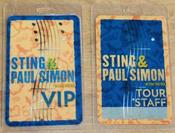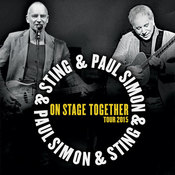
Paul Simon and Sting: On Stage Together
Paul Simon & Sting at the Milan Forum...
Take two giants of music, take a handful of songs that have shaped the history and culture of the last few decades, take two classy bands. Put them all together with a few thousand people. What do you get? A great concert that's a party, from start to finish.
Take two giants of music, take a handful of songs that have shaped the history and culture of the last few decades, take two classy bands. Put them all together with a few thousand people. What do you get? A great concert that's a party, from start to finish.
The equation isn't actually that obvious—because Sting and Paul Simon are friends, yes, and that's why they decided to tour together. But the English and American singers come from different, yet similar, worlds; two worlds that meet halfway in the concert, thanks to the power of the songs, thanks to the ability of the two artists to put themselves on the line, merging their respective musicians and their respective sounds in a game of musical chairs.
When the musicians take the stage at the Forum, it's anything but "late in the evening," to paraphrase the title of a song that will be played later. It's barely 8:00 PM: the concert was actually scheduled for 7:30 PM, but too many people were still queuing outside at that unusual time, which will be explained by the length of the setlist and the evening.
It's easy to get lost counting the musicians: two drum kits, percussion, guitars, two basses, keyboards, backing vocals, and horns: there are a full 14 of them. And then they arrive: Sting has a lean, boyish physique, accentuated by a T-shirt and tight pants, a long, almost hipster-like beard, his hair slicked back, and he towers (in height, of course) over the small, great man Paul Simon, hidden under a hat.
The unusual structure of the show is clear from the start. Joint tours are not unheard of (Bob Dylan & Mark Knopfler, a few years ago, Paul Simon himself with Bob Dylan, to name the first that come to mind), but here the two musicians play together, merging and separating their bands at times: they begin with a joint set, followed by two individual sets each, each punctuated by joint performances.
The party kicks off right away with "Brand New Day" and "Boy in the Bubble," whose lyrics sound more relevant than ever given the sea of cell phones and raised screens: "These are the days of miracle and wonder/This is the long-distance call/The way the camera follows us in slo-mo/The way we look at us all." I confess I got in on the act too, trying to do a couple of microstreams on Periscope, the new Twitter app.
Shortly thereafter, Sting delivers a decidedly "old-school" set, proving that he's infinitely better when he plays straightforward pop-rock, without getting lost in madrigals, symphonic arrangements, wintry records, or maritime musicals. "So Lonely" brings the audience to their feet for the first time, "When the World Is Running Down" recalls his jazz past (with a spectacular solo by David Sancious on keyboards), and so on until "Walking on the Moon." Simon returns for a "Mrs. Robinson," perhaps a little lopsided, but still thrilling: the two's voices work better on the shared ground of the more intense and less rhythmic song: the duet on "Fragile" is beautiful and the final one on "Bridge Over Troubled Water" is moving. Simon sets the pace with his band, playing with world music genres, as always, from zydeco to African sounds, from Brazil to country to blues (the coda to "Hearts and Bones" with "Mystery Train" and "Wheels" is wonderful). The repertoire is so “all killer, no filler” that even wonderful pieces (and perfect in this context as a variation) like Sting’s “Desert Rose” end up seeming minor, even if they are not.
Sting and Simon have a common habit of rearranging songs, changing their structure but leaving them perfectly recognizable and singable: the soulful coda of "Ain't No Sunshine" within "Roxanne" is wonderful, for example, or the many refined touches in Simon's arrangements.
And, through it all, the audience sings. And dances. And they don't sit in the stalls, but often move under the stage, in a dance with security: at the start of one of the classics, they move under; after a few songs, they're sent back to their seats, as befits an adult audience, which tonight, however, doesn't feel like being one, especially when it comes to singing the "lailalai" from "The Boxer" or "Message in a Bottle." Another classic, the crowd goes back under, and then they're sent away. And so it goes until the end of the concert.
It arrives after more than 30 songs and nearly three hours, with four songs at once, three truly classic classics ("Cecilia," "Every Breath You Take," and the masterfully sung "Bridge Over Troubled Water"), plus a final Everly Brothers cover, without a band. Just two voices, two guitars, and one song.
It may be nostalgic, but music and audiences need this: evenings of great songs, great voices, and artists who celebrate themselves, but also put themselves on the line, and who enjoy themselves and those of us in the audience. We'd like to see more tours like these.
(c) Rockol by Gianni Sibilla




